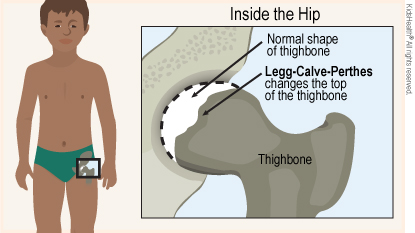Legg–Calvé–Perthes (leg kal-VAY PER-teez) disease, also called Perthes disease, is a problem that changes the shape of the top of the thighbone (femur). The bone doesn't fit into the hip joint normally, causing pain and limping.
The goals of treatment are to relieve pain, help with hip movement, and help the bone grow back to a normal shape. The kind of treatments needed depend on your child's age and the amount and type of changes in the thighbone. Your orthopedic (bone) specialist may recommend medicine for pain and inflammation (irritation and swelling), physical therapy, limiting activity, casting or bracing, or surgery.


Follow your orthopedic specialist's recommendations for:

Your child has:


What happens in Legg–Calvé–Perthes disease? Doctors don't know why, but in Legg–Calvé–Perthes disease, not enough blood reaches the top of the thighbone (the femur) where it forms the ball part of the hip joint. The bone cells don't have enough nutrients, and they die. The body breaks down that part of the bone and the shape of the bone changes. It may not fit well inside the hip socket, causing pain and trouble moving the hip. After a few months, the body starts to rebuild the bone. Treatment helps the body rebuild the bone in the right shape so that it fits well inside the hip socket.
How long will my child need care for Legg–Calvé–Perthes disease? It usually takes about 2–3 years from the time symptoms start until the bone is finished rebuilding. During this time, X-rays and exams every few months are important ways to know how the bone is rebuilding.
Who does Legg–Calvé–Perthes disease affect? Most kids with the condition are 4–10 years old. It is more common in boys and can happen in one or both hips.
What long-lasting problems can happen from Legg–Calvé–Perthes disease? Most kids don't have long-lasting problems. But sometimes even with treatment, the bone doesn't grow back into a shape that fits well into the hip joint. This can lead to: